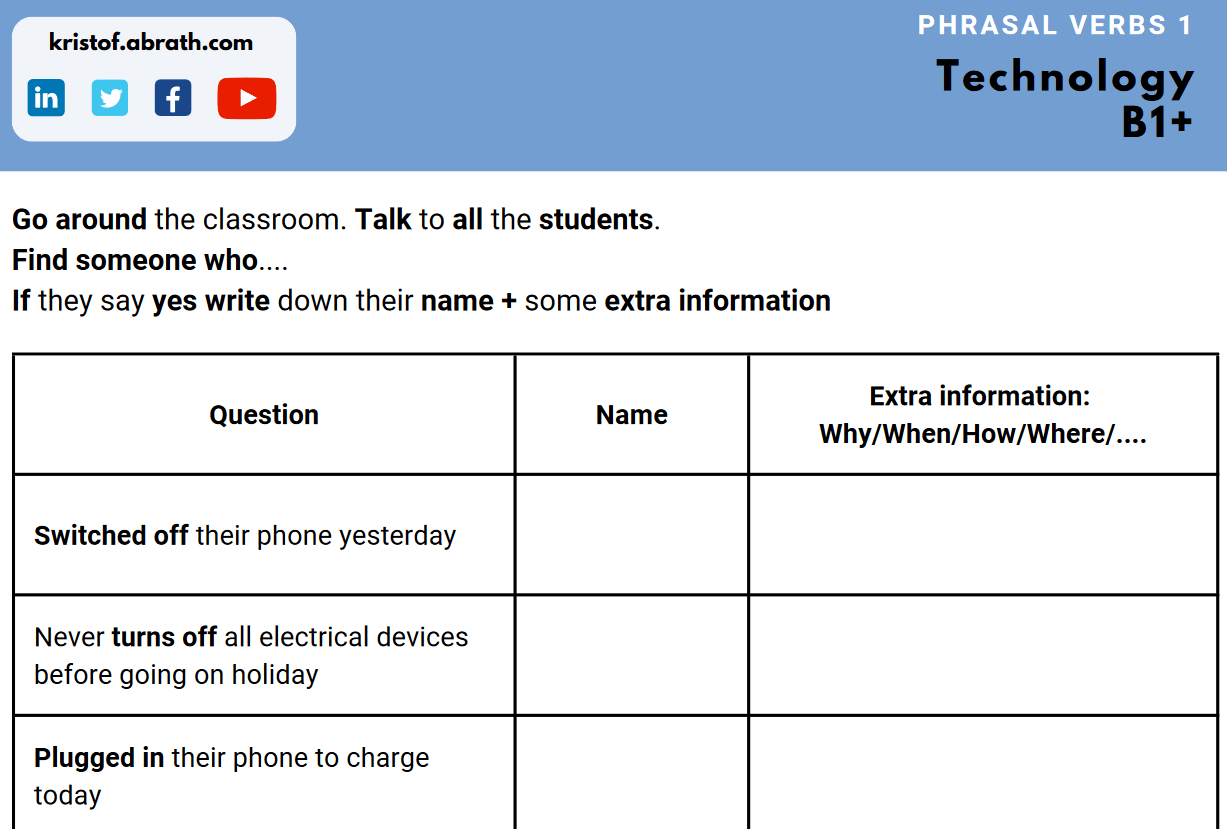Teachers' Games and Activities
Find Someone who...

Find someone who
This classic ESL English mingle is one every teacher should know because it is so versatile. It gets the students moving, talking to each other and asking questions about any vocabulary topic or grammar point.
What?
It’s a mingle and free/ freer speaking activity around a central vocabulary topic or grammar point.

What do you need?
- You need to have a ‘find someone who’ worksheet with some statements on it.
- You need enough copies for every student
- The students need a pen to write some information down
- You need some space for your students to move around the room
How does it work?
- You give the students the ‘find someone who’ worksheet
- The students make questions of the statements on their worksheet:
- Find someone who:
- Skipped lunch yesterday
- Did you have lunch yesterday?
- Skipped lunch yesterday
- Find someone who:
- They move around the room and ask different students the question
- When the student says yes, they write down their name and some additional information about, why? when? Where?how? What?…
- If the student say no, they ask the question to a different person until they find someone who does say yes, or until the time is over.
How long does it take?
It all depends on how many students you have in the class, how many questions you have and how difficult it is for the students to find someone who says yes. Still, I would say take at least 15 minutes for it. You could do it in 10 or extend it to 20, but 15 minutes is the sweet spot. You can always extend the activity by doing open class feedback and asking: ‘Who went to Paris?’ and ask them to tell some more information to the whole class. This can easily add a few minutes to the whole activity.
Who is it for?
It’s for any age that can read and write. For the smaller ones they will need some additional support, or it will take a few tries before they are used to the activity and know what needs to be done.
You can do it with any level, from Elementary (A1) to proficiency (C2).
Why use it?
- It’s a free speaking activity, so it’s and ideal activity at the end of your lesson
- It gets the students moving
- You can use it for any vocabulary or grammar point
- It’s extremely versatile
How to scaffold?
- You can give them a set of questions to choose from.
- They can brainstorm different questions in small groups or on the board.
- You need to make sure there is enough space for the students to move, else they will just stay on their chairs and not mingle
- For lower levels you will need to scaffold the worksheet
- Tell students to move regularly and find a new partner or they will stay with the same person for almost the whole activity
You can either just adapt the worksheet and instead of statements just have the questions: Find someone who has been to Paris: Have you been to Paris? This is really suitable for the lower levels.
You can also explain to them how it works and make the questions together with the whole class before doing the activity. That way they know how it works and can make the questions when they talk to their partner
You can always model the activity with a student/ students and show them how it works
- I have used it to teach any tense in the English language:
- Find someone who
- didn’t go to work yesterday (simple past)
- goes to the gym twice a week (present simple)
- has been to Paris (present perfect)
- …
- Find someone who
- I have used it to teach any vocabulary point
- Find someone who
- Likes to eat pizza (food)
- Has broken a leg (health)
- Loves staying in with a good book (phrasal verbs)
- Has burned the midnight oil recently (idioms)
- …
- Find someone who
- I have used it in my children, teen and adult classes
- I have used it with all levels
- I have used it in exam classes (CAE, FCE, IELTS)
- I have used it in business classes.
So, now you don’t have any excuse anymore for not letting the students move around in your class!
And if you have used it before, tell us all about your favourite in the comments below. If you haven’t used it tell us how you would use it.
Spread the word
Kristof Abrath
Teacher, Trainer, Course Designer
Teaching in English on 4 different continents since 2006.